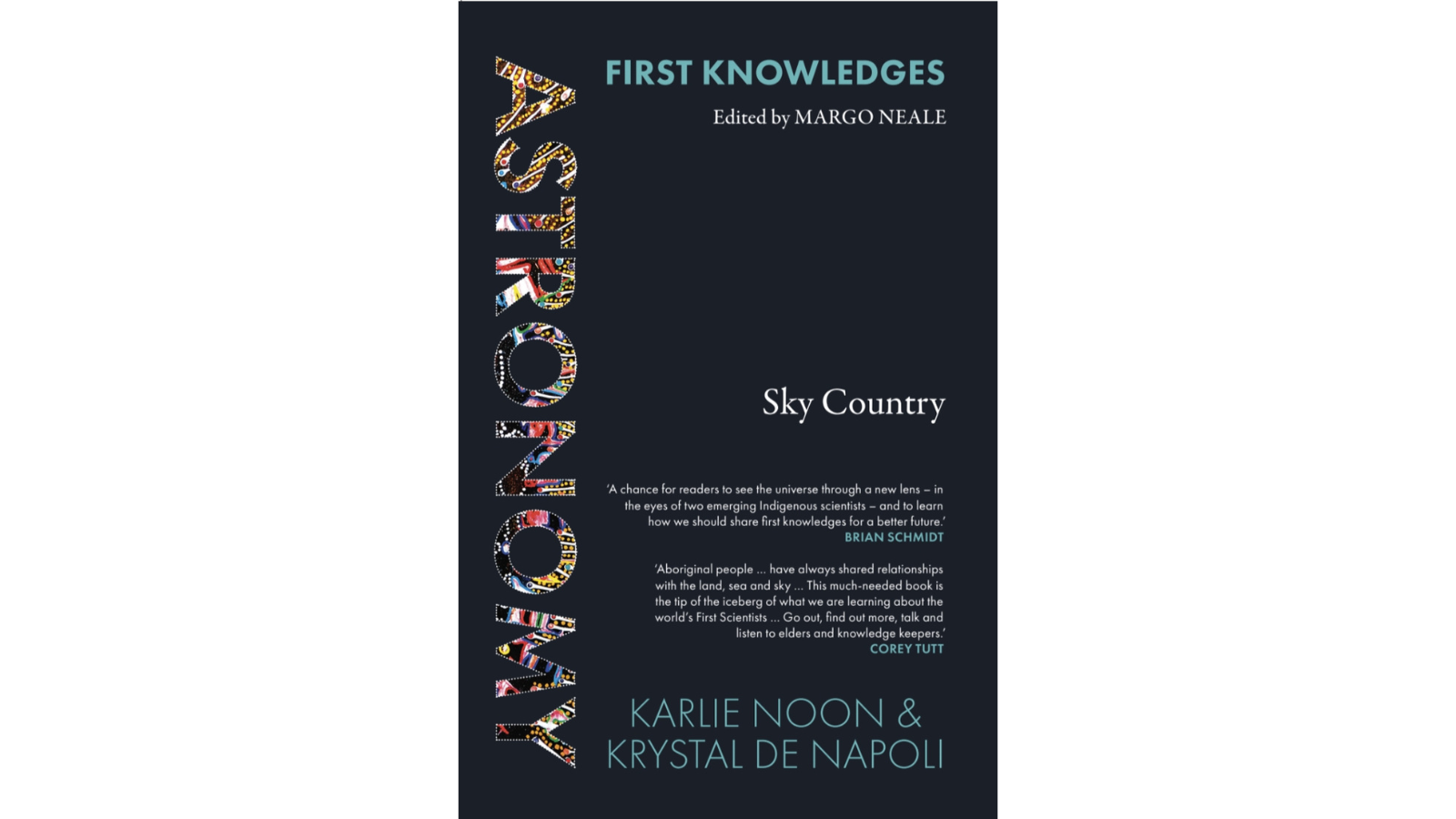Award for Indigenous Writing Shortlist

Title: Astronomy: Sky Country
Author: Karlie Noon and Krystal De Napoli
Publisher: Thames & Hudson Australia
What do you need to know to prosper for 65,000 years or more? The First Knowledges series provides a deeper understanding of the expertise and ingenuity of Indigenous Australians.
Aboriginal and Torres Strait Islander people are the oldest scientists in human history.
Many First Peoples regard the land as a reflection of the sky and the sky a reflection of the land. Sophisticated astronomical expertise embedded within the Dreaming and Songlines is interwoven into a deep understanding of changes on the land, such as weather patterns and seasonal shifts, that are integral to knowledges of time, food availability, and ceremony.
In Astronomy: Sky Country, Karlie Noon and Krystal De Napoli explore the connections between Aboriginal environmental and cultural practices and the behaviour of the stars, and consider what must be done to sustain our dark skies, and the information they hold, into the future.
Judges’ report
An incredibly well-researched and critical text that explores the connection between environment, land, weather patterns and seasonal shifts. By drawing on the idea of the sky as an archive for our knowledge systems, the book takes us through the Songlines and Dreaming stories that are held within our stars, through lightness and darkness.
Astronomy: Sky Country has the ability to educate and inform people to shift their perceptions of our cultures, by drawing on a deep understanding of Aboriginal and Torres Strait Islander people as the oldest scientists.
Extract
STAR MAPS AND NAVIGATION
Considering the depth and value of Indigenous sky knowledge, it is no surprise that Aboriginal and Torres Strait Islander communities have developed tools for safely navigating across our vast lands. Reasons for travelling across and outside Country include harvesting seasonal foods and resources, accessing different parts of Country, such as grindstones for baking, cooking and ceremonies, and trade. Trade was a significant feature in pre-contact Indigenous Australia and was a common reason for leaving Country, with tracks covering the entire continent (Figure 3.10) and beyond. This meant that travellers were required to observe and practise appropriate protocols when visiting other people’s land. Message sticks and Songlines helped to communicate these protocols. Notably, Aboriginal peoples also have a significant trade history with the Macassan people of southern Sulawesi, Indonesia. The Macassan people would travel to the Kimberley in Western Australia and Arnhem Land in the Northern Territory every December to trade sea cucumber, signifying precolonial bilateral marine cooperation and management.
As for inland Australia, goods such as sandstone, ochre, pituri (a smokable narcotic), tools, body adornments and food were all traded and shared with other communities. One of the most extravagant examples of the trade networks is that of the Channel Country, at the borders of what are now Queensland, South Australia and New South Wales. The Mithaka people of the region have worked with researchers to uncover not only trade networks but villages, discovering evidence of gunyah (houses), food storage systems and large quarries where ochre, stone and quartz crystals were mined. The Dieri people of the same region travelled to places 800 kilometres away for a specific colour of ochre. Clearly, travelling such vast distances, particularly through such arid country, requires sophisticated navigational methods to ensure survival.
Aboriginal and Torres Strait Islander peoples have developed many different ways to navigate. Some travel strictly by day or night, across land or sea, depending on their Country and destination. In the desert, people often navigate by land features, which serve as mnemonics along the Songlines. Though many, if not most, use the Songlines to travel across their own Country, skies are needed to travel outside of their Country. For the Wardaman people of the Northern Territory, travelling by night is preferred in order to take advantage of the cool air and stars, which can be used as guides.33 For those who travel across water, a Dreaming or Songline relating to a canoe constellation is common. In the Torres Strait, there is an impressively large and significant constellation known as Tagai, a Creator Being. Tagai’s body is the constellation Scorpius, with the Southern Cross as his left hand and the Corvus constellation his right. The Tagai constellation aids in navigation in a variety of ways, such as the use of directional stars: Tagai’s left hand points south, for example. As explained on the website of Tagai State College, which is named after the Creator Being,
Tagai is also described by Elders as the ‘heavenly clock’. Tagai directs the seasonal changes and his visibility in the night sky throughout the year tells Aboriginal and Torres Strait Islander people in the region how to adapt to the wind and tidal movements, and the best times to hunt, fish, plant and harvest. The Southern Cross is easily recognisable in the star formation that represents Tagai’s left hand that is holding his spear. In his right hand, Tagai is holding the branch of the red-skinned fruit known as ‘sorbi’.
Yolŋu traditions describe Venus as the morning star, a female spirit who guides other spirits to their destinations. This is a Songline that incorporates Venus’s journey across the Top End. It details many of the land’s features, such as waterholes, on the terrestrial part of her journey. As such, the Venus or Barnumbirr Songline acts as an oral map for some Yolŋu clans. However, it is more than a cartographic map: it is also a cultural map laid down by the ancestors incorporating knowledge and lessons about the spiritual and the ecological, as well as the rules and protocols of not only surviving but living properly. Each site links together to create the Songline and focuses on different lessons.
Star maps were another technique developed by nations to aid travel. The Kamilaroi and Euahlayi nations used ‘patterns of stars to represent routes of travel on land’. For example, each star in a constellation refers to a specific landmark on the ground, while the pattern as a whole indicates direction. The landmarks may be features such as waterholes, or indicators of where direction may need to be adjusted.
About the authors

Karlie Noon is a Gamilaraay astronomer and science communicator who has worked with audiences around the country for the past ten years promoting Indigenous astronomical knowledge systems and advocating for more women in STEM. Karlie is the first female Indigenous Australian to graduate with combined degrees in mathematics and science. She holds a Masters of Astronomy and Astrophysics and is currently undertaking a PhD in astrophysics.
 Krystal De Napoli is a Kamilaroi educator and astrophysicist devoted to the advocacy of Indigenous knowledges and equity in STEM. She is undertaking an honours degree and researching star formation rates in galaxies. In 2018 Krystal became the first astrophysicist to be awarded the Illumina Women in Genomics bracelet, and she has curated a national public database on Indigenous science for the Australian Council of Deans of Science.
Krystal De Napoli is a Kamilaroi educator and astrophysicist devoted to the advocacy of Indigenous knowledges and equity in STEM. She is undertaking an honours degree and researching star formation rates in galaxies. In 2018 Krystal became the first astrophysicist to be awarded the Illumina Women in Genomics bracelet, and she has curated a national public database on Indigenous science for the Australian Council of Deans of Science.
Related Posts

Read
Anne-Marie Te Whiu Receives The Next Chapter Alumni Poetry Fellowship
2 Apr 2024

Read
What's on in April: Resident Organisation Round Up
28 Mar 2024

Read
Blak & Bright First Nations Literary Festival returns in 2024
7 Mar 2024

Read
What's on in March: Resident Organisation Round Up
29 Feb 2024

Read
Hot Desk Extract: International
23 Feb 2024

Read
Hot Desk Extract: The Rooms
23 Feb 2024
Share this content